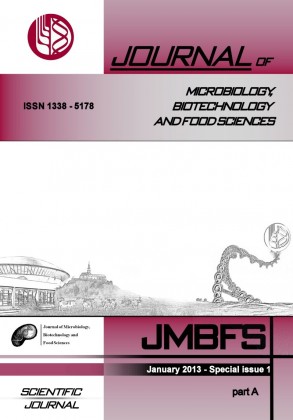ASSOCIATION OF SINGLE NUCLEOTIDE POLYMORPHISMS IN THE LEPR CANDIDATE GENE WITH CARCASS TRAITS OF PIGS
Keywords:
pig, LEPR (HpaII), carcass trait, genotypic valueAbstract
Leptin and leptin receptor genetic variants are associated with obese phenotypes in humans and mice and are expected to influence fat deposition in pigs. This study aimed to investigate the associations of LEPR polymorphism with carcass traits (half carcass weight, lean meat percentage, back-fat thickness, MLT area - musculus longisimus thoracis) and evaluation of genotypic values, additive values and dominance deviations. To identify the genotypes of LEPR candidate genes, we used biological material obtained from sows (55) and boars (51) of hybrid combination Large White x Landrace after reaching the slaughter weight. We identified three genotypes using restriction endonuclease HpaII in a group of 106 pigs. The AA genotype was the dominant one (42.45%), AB heterozygotes constituted 39.62%, while the BB genotype was the lowest (17.93%). Analyzing the half carcass weight the highest value detected was the highest in the dominant AA homozygotes together with the highest genotypic value (GAA = 0.3649). The pork genotype AA presented the highest back-fat thickness, A high correlation between the additive genetic effect of the A allele and back-fat thickness (0.8183) has been observed while the effect of the allelic dominance was relatively low (0.1907). Based on our results we may conclude that there is an inverse and antagonistic relationship between the quality of the half carcass weight together with the back-fat thickness and the lean meat marker.Downloads
Download data is not yet available.
Downloads
Published
2013-02-01
How to Cite
KováÄik, A., Trakovická, A., Bulla, J., & Navrátilová, A. (2013). ASSOCIATION OF SINGLE NUCLEOTIDE POLYMORPHISMS IN THE LEPR CANDIDATE GENE WITH CARCASS TRAITS OF PIGS. Journal of Microbiology, Biotechnology and Food Sciences, 2(special issue 2), 1417–1425. Retrieved from https://office2.jmbfs.org/index.php/JMBFS/article/view/7472
Issue
Section
Biotechnology
License
Copyright (c) 2013 Anton KováÄik, Anna Trakovická, Jozef Bulla, Alica Navrátilová

This work is licensed under a Creative Commons Attribution 4.0 International License.
All papers published in the Journal of Microbiology, Biotechnology and Food Sciences are published under a CC-BY licence (CC-BY 4.0). Published materials can be shared (copy and redistribute the material in any medium or format) and adapted (remix, transform, and build upon the material for any purpose, even commercially) with specifying the author(s).

